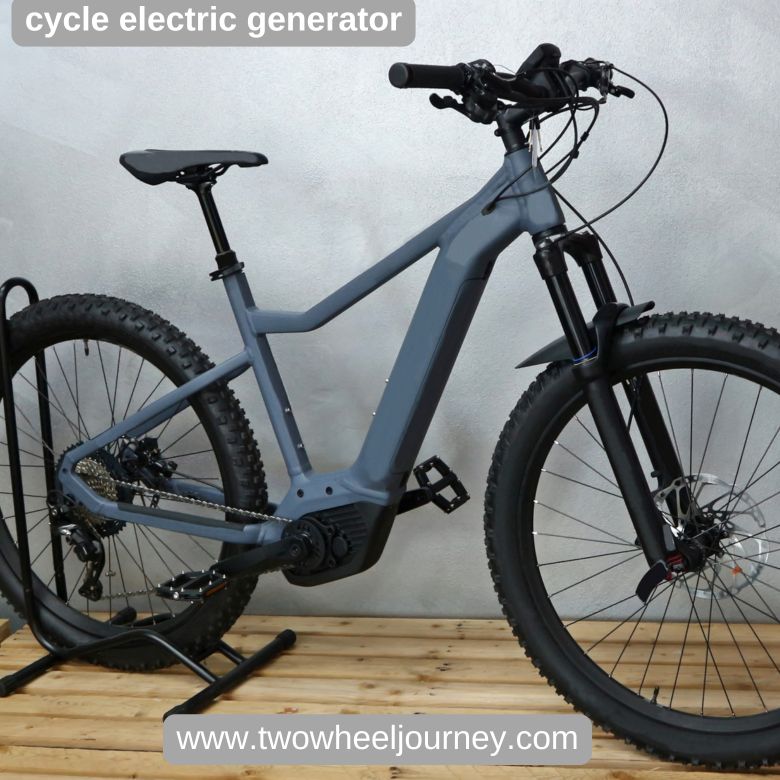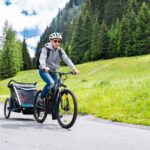In today’s world, the push for sustainable energy solutions has never been more critical. Amidst the various technologies vying for attention, the cycle electric generator stands out as a practical and innovative method to harness human power for electricity generation. Imagine pedaling your way to a greener future, where each revolution of your bicycle wheels not only propels you forward but also generates clean, renewable energy. This concept merges the simplicity of cycling with the sophistication of electrical engineering, offering a dual benefit: staying fit while producing power.
electric generators convert the mechanical energy of pedaling into electrical energy, which can be stored in batteries or used to power devices directly. This technology is not only environmentally friendly but also highly accessible, requiring minimal infrastructure. From urban dwellers seeking a sustainable alternative to gym workouts to remote communities needing off-grid power solutions, the applications are diverse and far-reaching. The beauty of the cycle generator lies in its simplicity and versatility, making it an attractive option for individuals and communities alike. As we pedal towards a more sustainable future, this innovative approach exemplifies how traditional practices can be reimagined to meet modern energy needs, blending exercise with eco-conscious living in a truly impactful way.
Ride and Recharge: The Future of Cycle Electric Generators
In an era where sustainability and innovation intersect, cycle electric generators are emerging as a groundbreaking solution for clean energy production. Combining the benefits of physical exercise with the generation of renewable electricity, these devices hold promise for a future where individuals can power their gadgets, charge batteries, and even contribute to the grid simply by pedaling. This comprehensive guide explores the mechanics, benefits, applications, and future potential of cycle electric highlighting how this technology can reshape our approach to energy consumption and fitness. For more information visit here
Table of Contents
How Cycle Electric Generators Work
Cycle electric convert mechanical energy from pedaling into electrical energy through a straightforward yet ingenious process. Here’s a step-by-step breakdown:
- Pedaling Mechanics: As you pedal, the bike’s crankset turns the chain, which drives the rear wheel or a connected flywheel.
- Generator Mechanism: Attached to the rear wheel or flywheel is a generator, often a dynamo or alternator, which converts the rotational energy into electrical energy. This process involves the use of magnets and coils to induce an electric current.
- Energy Conversion: The generated electrical energy is usually in the form of alternating current (AC). It is then rectified to direct current (DC) using a rectifier, making it suitable for charging batteries or powering devices.
- Storage and Usage: The DC electricity can be stored in a battery pack for later use or directly used to power electronic devices, lights, or other small appliances.
- Monitoring and Regulation: Advanced setups include voltage regulators and monitoring systems to ensure the output is consistent and safe for the connected devices.
Benefits of Cycle Electric Generators
1. Sustainable Energy Production
Cycle electric generators provide a renewable energy source, reducing reliance on fossil fuels and decreasing carbon footprints. Each pedal stroke contributes to a cleaner environment.
2. Physical Fitness
Cycling is an excellent form of cardiovascular exercise. Incorporating an electric generator into your bike routine ensures that your workout contributes to both personal health and energy production.
3. Energy Independence
For off-grid living or during power outages, cycle electric generators offer a reliable backup power source. This independence can be crucial in remote areas or during natural disasters.
4. Educational Tool
These generators serve as practical tools for teaching principles of physics, energy conversion, and sustainability. Schools and educational institutions can incorporate them into science curriculums to provide hands-on learning experiences.
5. Cost Savings
By generating your own electricity, you can reduce energy bills. While initial setup costs exist, the long-term savings on electricity can be significant.
Applications of Cycle Electric Generators
1. Home Energy Solutions
Integrating cycle electric generators into home energy systems can provide supplementary power. For instance, they can be used to charge batteries that power household lighting or small appliances, reducing overall electricity consumption.
2. Fitness Centers
Gyms and fitness centers can install stationary bikes equipped with generators. Members can contribute to the facility’s energy needs while working out, creating a green and sustainable exercise environment.
3. Portable Power Stations
Cycle generators are ideal for camping and outdoor activities. Portable setups can provide electricity for lights, cooking equipment, and electronic devices, ensuring you stay connected even in remote locations.
4. Emergency Preparedness
In emergency situations where the power grid is compromised, cycle electric can offer a reliable source of power for essential devices like radios, flashlights, and mobile phones.
5. Community Projects
Community centers and public spaces can adopt cycle electric to promote sustainability and community engagement. These projects can raise awareness about renewable energy and encourage communal efforts towards green living.
Setting Up a Cycle Electric Generator
1. Choosing the Right Bicycle
Both stationary and road bicycles can be converted into electric generators. Stationary bikes are often preferred for their stability and ease of use, but road bikes offer versatility for dual-purpose use.
2. Selecting the Generator
The core component is the generator. Options include:
- Hub Dynamos: Installed in the wheel hub, these are efficient and commonly used for bike lights.
- Bottle Dynamos: Attached to the bike frame, these are less efficient but easier to install.
- Alternators: More powerful and suitable for higher energy demands.
3. Installation Process
- Mounting the Generator: Attach the generator to the rear wheel or flywheel. Ensure it is securely mounted to avoid slipping or damage during pedaling.
- Connecting the Wiring: Run wires from the generator to the rectifier and battery pack. Ensure all connections are secure and insulated to prevent short circuits.
- Setting Up the Battery Pack: Choose a suitable battery pack based on your energy needs. Lithium-ion batteries are commonly used for their efficiency and longevity.
- Regulating Voltage: Install a voltage regulator to maintain a consistent output, protecting connected devices from power surges.
- Monitoring Systems: Consider installing an energy monitor to track power generation and usage. This helps optimize performance and identify any issues.
4. Maintenance
Regular maintenance ensures the longevity and efficiency of your cycle generator. Key maintenance tasks include:
- Checking Connections: Regularly inspect all electrical connections for wear and tear.
- Lubricating Moving Parts: Keep the bicycle and generator components well-lubricated to ensure smooth operation.
- Battery Care: Follow manufacturer guidelines for battery maintenance, including regular charging and avoiding deep discharges.

Case Studies: Real-World Applications
1. Pedal Power in Uganda
In rural Uganda, where electricity access is limited, cycle electric are providing a lifeline. Community centers equipped with these generators offer charging stations for mobile phones and batteries, empowering residents with connectivity and light.
2. Green Gyms in the USA
Several gyms across the USA have embraced the concept of green energy by installing cycle electric generators. Members’ workouts contribute to powering gym equipment and lighting, significantly reducing the facilities’ carbon footprints.
3. Disaster Relief in Puerto Rico
After Hurricane Maria devastated Puerto Rico’s power infrastructure, cycle electric became essential for emergency relief. These generators provided critical power for communication devices and medical equipment, showcasing their importance in crisis situations.
Future Potential and Innovations
1. Enhanced Efficiency
Ongoing research aims to improve the efficiency of cycle electric generators. Innovations in generator design and materials can lead to higher energy conversion rates, making these devices more effective and appealing.
2. Integration with Smart Grids
Future developments could see cycle electric integrated with smart grids, allowing excess energy to be fed back into the grid. This would not only benefit individual users but also contribute to community-wide energy sustainability.
3. Wearable Technology
Innovators are exploring the potential of wearable technology that can generate electricity through human movement. This could include smart clothing or accessories that harness kinetic energy, expanding the concept of human-powered electricity beyond bicycles.
4. Urban Mobility Solutions
Electric bicycles equipped with generators can provide sustainable urban transportation solutions. These bikes could offer a dual function, serving as both a mode of transport and a personal power source, further promoting green living in cities.
Addressing Common Challenges
While cycle electric generators offer numerous benefits, there are also challenges that need to be addressed to maximize their effectiveness and adoption.
1. Energy Output and Efficiency
One of the primary challenges is the relatively low energy output compared to other renewable energy sources like solar or wind. For a typical cyclist, generating around 100 watts of power per hour is common, which is sufficient for small devices but not for high-energy demands.
Solutions:
- Improved Generator Technology: Research and development in generator efficiency can help increase the amount of electricity produced.
- Energy Storage: Efficient battery systems can store generated energy for later use, making the power available when needed.
2. User Fatigue
Sustained pedaling can lead to user fatigue, limiting the amount of energy that can be generated in one session.
Solutions:
- Hybrid Systems: Combining cycle generators with other renewable sources can distribute the energy generation load.
- Ergonomic Design: Improved bike design can enhance comfort and reduce fatigue during long sessions.
3. Cost and Accessibility
Initial setup costs for cycle electric generators can be a barrier for some users, especially in developing regions.
Solutions:
- Affordable Options: Developing low-cost generator models and providing subsidies or financing options can make this technology more accessible.
- DIY Kits: Offering do-it-yourself kits with clear instructions can empower users to build their own generators at a lower cost.
4. Public Awareness and Adoption
Widespread adoption requires public awareness and acceptance of the technology.
Solutions:
- Educational Campaigns: Informing the public about the benefits and potential of cycle electric generators through campaigns and demonstrations.
- Community Programs: Implementing community-based projects that showcase the technology’s practical benefits can drive adoption.
Integrating Cycle Electric Generators with Other Technologies
Combining cycle electric with other renewable energy technologies and innovations can amplify their impact.
1. Solar Panels
Integrating solar panels with cycle generators can create a hybrid system that harnesses both human and solar energy. During the day, solar panels can charge batteries, while pedaling can supplement energy needs, especially in low sunlight conditions.
2. Smart Homes
Cycle electric generators can be integrated into smart home systems, where energy management systems optimize the use of generated power. Smart meters can track energy production and usage, ensuring efficient energy distribution within the household.
3. Internet of Things (IoT)
Connecting cycle generators to IoT devices can provide real-time monitoring and control over the energy production process. Users can track their energy output, battery levels, and overall efficiency through smartphone apps or connected devices.
Future Trends and Innovations
1. Advanced Materials
The use of advanced materials, such as lightweight composites and high-efficiency magnets, can enhance the performance of cycle electric generators. These materials can reduce weight, increase durability, and improve overall efficiency.
2. Modular Systems
Developing modular cycle generator systems can allow users to customize and expand their setup according to their energy needs. Modular components can include different types of generators, battery packs, and energy monitoring systems.
3. Collaborative Platforms
Platforms that allow users to share their energy generation data and experiences can foster a community of cycle generator enthusiasts. These platforms can provide valuable insights, troubleshooting tips, and motivation for continuous use.
4. Government and Policy Support
Government incentives and supportive policies can accelerate the adoption of cycle electric generators. Subsidies, tax credits, and grants for renewable energy projects can make these systems more financially viable for individuals and communities.
Community and Societal Impact
Cycle electric have the potential to create a substantial impact on communities and society at large. By promoting a culture of sustainability and self-sufficiency, they can drive significant changes in how we approach energy consumption and physical fitness.
1. Empowering Communities
In areas with limited access to electricity, cycle electric generators can empower communities by providing a reliable source of power. This can enhance the quality of life by enabling basic amenities like lighting, communication, and access to information.
Examples:
- Educational Facilities: Schools in off-grid areas can use cycle generators to power lights and computers, enhancing learning environments and educational outcomes.
- Healthcare Centers: Rural clinics can utilize these generators to operate essential medical equipment, ensuring better healthcare services.
2. Promoting Physical Activity
Encouraging the use of cycle electric generators can promote physical activity and healthier lifestyles. This dual benefit of generating power while exercising can be a strong motivator for individuals to stay active.
Examples:
- Workplace Wellness Programs: Companies can integrate stationary bikes with generators into their wellness programs, encouraging employees to stay fit while contributing to the office’s energy needs.
- Community Centers: Local gyms and recreation centers can adopt this technology to promote health and sustainability simultaneously.
3. Environmental Awareness
Implementing cycle electric generators in public spaces and educational institutions can raise environmental awareness and inspire individuals to adopt more sustainable practices.
Examples:
- Public Installations: Parks and community spaces can feature cycle generators as interactive exhibits, allowing visitors to learn about renewable energy in a hands-on manner.
- School Projects: Science and environmental clubs can build and use these generators as part of their projects, fostering a deeper understanding of energy conservation among students.
Technological Innovations and Future Research
1. Efficiency Improvements
Ongoing research focuses on improving the efficiency of cycle electric generators. Innovations in magnetic materials, coil designs, and energy conversion techniques can significantly enhance performance.
2. Integration with Renewable Energy Systems
Future developments may see cycle electric integrated with other renewable energy systems like wind and solar power. This hybrid approach can ensure a continuous and reliable energy supply, regardless of weather conditions or time of day.
3. Smart Connectivity
Advancements in smart technology can lead to the development of connected cycle electric generators. These smart systems can optimize energy production, storage, and usage, providing users with real-time data and control over their energy consumption.
Features:
- Energy Management Apps: Smartphone applications can allow users to monitor their energy generation, track performance, and manage their energy usage.
- Automated Systems: Smart generators can automatically adjust resistance levels and power output based on user preferences and energy needs.
4. Portable and Versatile Designs
Design innovations are leading to more portable and versatile cycle electric generators. These new models can be easily transported and used in various settings, from urban environments to remote locations.
Examples:
- Foldable Bikes: Compact and foldable bikes equipped with generators can be carried in cars or public transport, making them ideal for commuters.
- Multi-functional Equipment: Exercise equipment like elliptical trainers and treadmills can be modified to include energy-generating capabilities, expanding the use cases for this technology.
To sum up
With possible uses ranging from individualised exercise regimens to significant community projects, cycle electric generator have a bright future. Our ability to produce electricity from human energy can lead to the development of a self-sufficient and sustainable energy source that benefits human and environmental well-being.
Cycle electric are expected to become more effective, widely available, and ingrained in our daily lives as technology develops and public awareness increases. Adoption of this technology can be accelerated by the joint efforts of communities, legislators, and inventors, paving the way for a more sustainable era.
We are pedalling towards a future where every action matters in our collective journey towards sustainability when we embrace the ride and recharge concept. We are doing more than just producing electricity. In populated areas or in isolated










